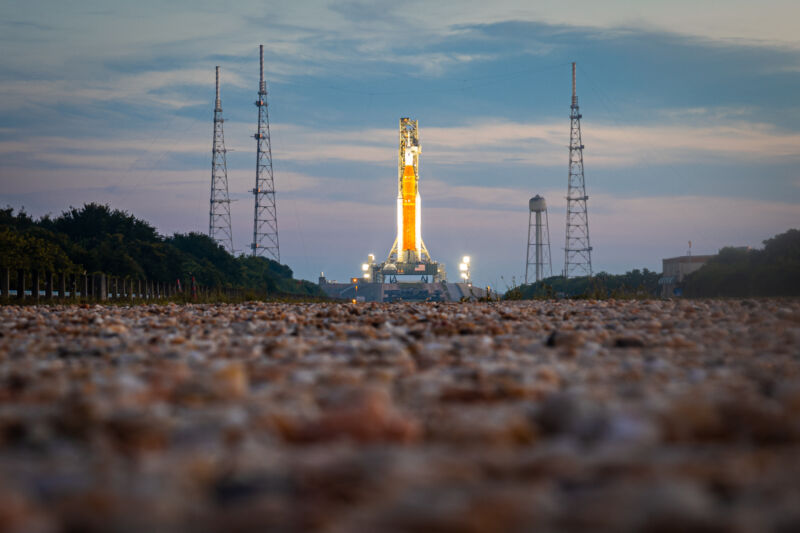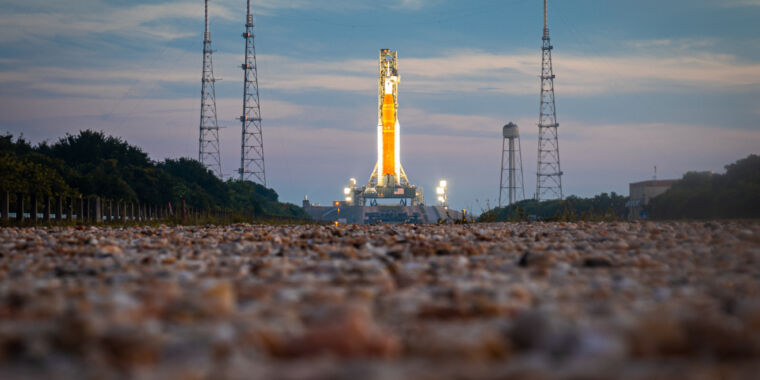
Trevor Mahlmann
11:15 am ET Saturday: NASA has officially scrubbed the Artemis I launch attempt on Saturday. The launch team was unable to solve a leak in an 8-inch hydrogen inlet leading to the Space Launch System rocket.
Launch officials attempted three troubleshooting measures, and none were able to substantially reduce the leak of cryogenic hydrogen when it flowed from ground systems on board the rocket.
It is not clear whether NASA will attempt to launch the Artemis I mission on Monday or Tuesday, or will need to roll back the massive rocket to the Vehicle Assembly Building for remedial work. The latter seems most likely, but a final decision has not been made. Ars will have a full recap story later on Saturday.
KENNEDY SPACE CENTER, Fla.—Five days after NASA’s first attempt to fly the massive Space Launch System rocket ended with technical problems, the space agency is ready to try again.
A launch team began fueling the rocket on Saturday morning shortly before the Sun began rising over the Atlantic Ocean waters that encircle the spaceport. The SLS rocket, which is launching the Artemis I mission around the Moon, has a two-hour launch window that opens at 2:17 pm ET (18:17 UTC).
A successful launch would mark the beginning of a 42-day mission that will send the Orion spacecraft into lunar orbit, and test critical technologies such as a heat shield that will protect the spacecraft during a fiery reentry through Earth’s atmosphere. If the mission goes well, Artemis II would follow in a couple of years, carrying humans around the Moon. A lunar landing is planned for later this decade.
Much will have to go right for the rocket to launch on Saturday. There are three primary reasons why rocket launches scrub: weather, range issues, and technical problems. The weather looks reasonably good for a Florida summertime afternoon, with at least a 60 percent chance of favorable conditions. Launch range issues, such as a boat traveling into restricted waters, are a low probability.
That leaves technical problems, and because the SLS is a complex, towering rocket with leaky hydrogen fuel, trying to launch for the first time—well, let’s just say a scrub is more likely than not. Prior to liftoff there are no fewer than 489 “launch commit criteria” that must be met for the SLS rocket, such as temperatures of propellants, tank pressures, and so forth.
“There’s no guarantee we’re going to get off on Saturday, but we’re going to try,” said NASA engineer Mike Sarafin, who serves as mission manager for Artemis I, during a news conference this week.
Monday’s scrub
The launch team decided to scrub Monday’s attempt even before the launch window opened after a series of problems delayed the countdown and bedeviled launch controllers. Storms pushed back the start of fueling operations; then there was a leaky hydrogen inlet leading to the rocket, and a problem with ice in the booster’s foam insulation.
But the biggest problem came when launch controllers attempted to chill down the four main RS-25 engines, which need to be at a very cold temperature of -420 degrees Fahrenheit at launch in order to handle the extremely cold propellants at engine ignition. A sensor in one of the four engines indicated it was not cooling down to a proper temperature.
Inside the Launch Control Center, some NASA engineers believed the sensor must be at fault, because there were other indications that the engine was cooling down as required. But time was running short, and given the other problems the launch team was working, it became too much, Sarafin said.
“One of the worst things you can do, when you find yourself in a hazardous condition, is to go further off script,” Sarafin said. “The team did absolutely the right thing on Monday.”
On Tuesday technicians and engineers worked on the vehicle and its ground systems, and gained confidence that it was indeed a problematic sensor at fault, rather than a chill-down issue. Among the key indicators was that liquid hydrogen had flowed through the engine, and exited at an expected temperature.
So for Saturday’s attempt NASA has not replaced the sensor, which would require rolling back to the Vehicle Assembly Building and a delay of at least a month, if not longer. If there is a scrub for any reason Saturday, NASA could have one more opportunity to launch the vehicle on Monday or Tuesday, before it will need to be rolled back for remedial work, regardless.
The official webcast for the mission will begin at 11:15 am ET (15:15 UTC) on Saturday. It is embedded below. NASA’s media channel will cover fueling operations, with live, intermittent commentary beginning at 5:45 am ET (9:45 UTC) on Saturday.
Official NASA webcast for the Artemis I mission.


![NASA scrubs second attempt to launch Artemis I after hydrogen leak [Updated]](https://cdn.arstechnica.net/wp-content/uploads/2022/09/Giant_Haasts_eagle_attacking_New_Zealand_moa-760x380.jpg)
![NASA scrubs second attempt to launch Artemis I after hydrogen leak [Updated]](https://cdn.arstechnica.net/wp-content/uploads/2022/09/GettyImages-1242131062-760x380.jpg)




